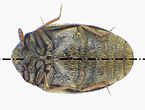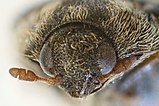Australian carpet beetle
| Australian carpet beetle | ||||||||||||
|---|---|---|---|---|---|---|---|---|---|---|---|---|

Australian carpet beetle ( Anthrenocerus australis ) |
||||||||||||
| Systematics | ||||||||||||
|
||||||||||||
| Scientific name | ||||||||||||
| Anthrenocerus australis | ||||||||||||
| ( Hope , 1843) |
The Australian carpet beetle ( Anthrenocerus australis ) is a beetle from the family of the bacon beetles (Dermestidae).
Comment on the name
Originally known from Australia beetle has very similar sensor as some species of the genus Anthrenus such as the varied carpet beetle . This is expressed in the name Anthrenocerus , which is derived from the generic name "Anthrenus" and "κερός" ("keros"), "horn", "feeler".
description
The shape of the beetle, which is up to 3.5 millimeters in size, is oval. The male is smaller than the female. The body color is red-brown to black. The antennae and legs are light amber. In places a bristly hair appears. It is white to yellowish, individual brown hairs can also be interspersed.
The head can be drawn a little into the fore chest (Fig. 3) and is then tilted down a little over ninety degrees. The antennae (green in Fig. 5) consist of eleven links, the last three links form a clearly separated, compact lobe, the first link of which is larger than the second. The feelers can be inserted into a recess in the front chest (brown in Fig. 5), which is below the side edge of the front chest. The pronotum is only slightly wider in front than the head, then it widens outwardly curved to almost the width of the elytra . At the base it is curved laterally inwards and in the middle outwards. The pronotum shows through the light hair on the side behind the middle one large transverse spot and several small spots at the base. The hair is rubbed off easily.
The wing covers have three narrow, bright zigzag bands caused by the hair and can also have white spots at the base and at the end. The zigzag bands can also be broken up into individual spots. An important feature of the genus is only visible on the underside of the body. The front chest is extended backwards between the front hips to form a so-called prosternal process (colored red in Fig. 6). This comes to lie in a furrow that completely cuts through the middle breast (colored green above in Fig. 6) and extends to the rear breast (blue in Fig. 6 above). The legs and rails are delicate and flattened. The tarsi are all five-limbed with a long claw limb.
larva
The larva here is up to six millimeters long. The color is brown, yellowish and white below. She also has arrow hair. Their diet consists of all kinds of woolen goods and other animal materials.
Way of life
The beetles probably spread from England through the Netherlands and then to Germany . It is now a widespread home pest in northwest Germany.
The larva of the Australian carpet beetle prefers to eat its way into wool and leather products. They can also cause considerable damage through keratin consumption.
The Australian carpet beetle differ from the other species of bacon beetles in that they can produce up to three generations per year. Fresh beetles hatch almost all year round, with the exception of the winter months.
In Australia , the beetles are mainly found on flowers, where they feed on pollen, while according to current knowledge in our latitudes they are entirely limited to life inside buildings.
The development of the eggs and their number seem to be temperature-dependent, with the larva hatching at the ideal temperature of 22 ° C after a maximum of 12 days and then immediately starting to eat. It is not known whether the carpet beetle will still eat in the short period of adulthood.
The number of larval stages also depends on the temperature and the food. At room temperature, the larva develops into a beetle in two months.
literature
- Heinz Joy, Karl Wilhelm Harde, Gustav Adolf Lohse: The beetles of Central Europe . tape 6 : Diversicornia . Spectrum, Heidelberg 1979, ISBN 3-87263-027-X . P. 327
- Klaus Koch : The Beetles of Central Europe Ecology . 1st edition. tape 2 . Goecke & Evers, Krefeld 1989, ISBN 3-87263-040-7 . P. 132
Individual evidence
- ↑ Gilbert J. Arrow: Notes on the Coleopterous Family Dermestidae ... in The Anals and Magazin of Natural History Vol. 15, London 1915 p. 443
Web links
- LAVES: Australian carpet beetle Nds. State Office for Consumer Protection and Food Safety, date of creation unknown, accessed: May 27, 2014
- Stiftung Warentest: Special pests in house and garden test.de, August 28, 2002, accessed: December 20, 2012







